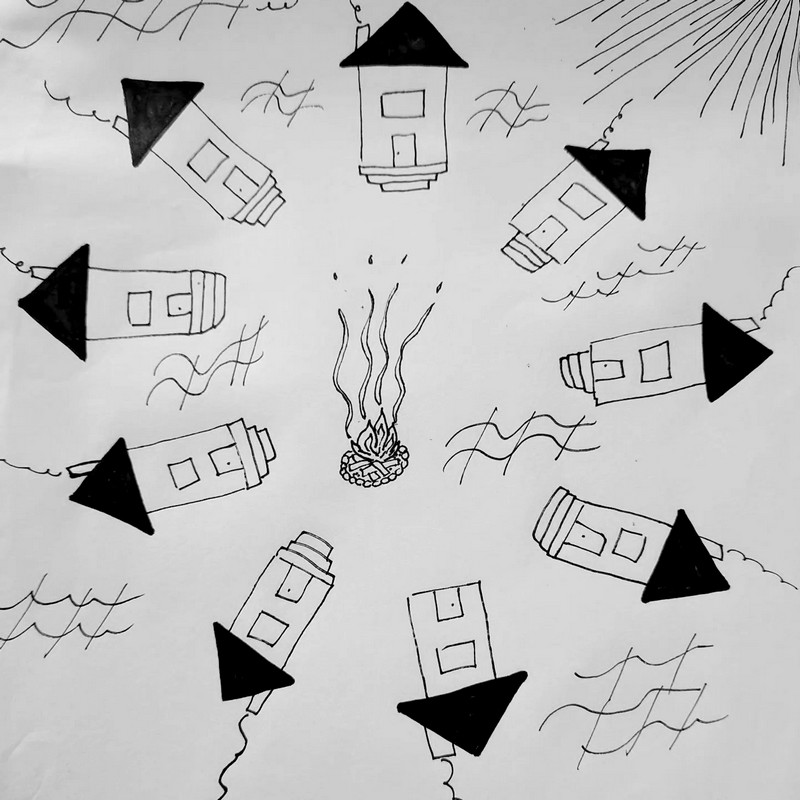Architects Against Housing Alienation – Not for Sale!: 2. On the Land Housing
Architects Against Housing Alienation (AAHA) occupied the Canadian Pavilion at the Venice Biennale of Architecture in 2023 with Not for Sale!, their campaign of ten demands for decommodified housing in c\a\n\a\d\a. The following is an extended description of one of these demands and proposal made up of an activist strategy, a plan for implementation, and an architectural project

2. On the Land Housing
We demand on the land housing. After decades of calls for action, the National Inquiry into Missing and Murdered Indigenous Women and Girls found that among the root causes of this inordinate violence is insecure housing and homelessness. To build a deep connection to home, we demand on the land, off-grid communities for Indigenous women and girls with access to safe, secure, affordable, culturally relevant wrap around support services.

Indigenous women and girls across c\a\n\a\d\a are disproportionately impacted by domestic and other forms of structural violence, often leading to a choice between living in a threatening situation or losing their access to shelter. In response, we seek to prevent homelessness and unsheltered living for young Indigenous women as summarized in the Final Report of the National Inquiry into Missing and Murdered Indigenous Women and Girls (MMIWG) in c\a\n\a\d\a.

We demand federal and territorial funding for women-focused, on-the-land camps so that Indigenous women can access a sense of home in a safe community environment, as well as participate in on-the-land activities to experience the healing power of cultural revitalisation. This demand seeks to address the need for housing options for young Indigenous women that are not dependent upon having children or being in a partnered relationship. We demand that these homes be built off-grid to promote self-determination and traditional living free of rent, utility payments, and other potential sources of debt or arrears. The camps, though land-focused, should be located in reasonable proximity to jobs, on underutilized lands in or near cities, or with clear connections to amenities. The design process should be informed by traditional land-based knowledge and the specific needs of the women who will live in these new communities.

As a first step, we demand that the federal and Northwest Territories government fund the creation of a pilot On the Land community in the Yellowknives Dene First Nation to be led by Indigenous women. On the Land housing will necessitate intergovernmental collaboration between federal, territorial, municipal and Indigenous governments. Funding and financing the project will come from federal, territorial, and municipal governments to be led at each step by Indigenous organizations; possible funders include Canada Mortgage and Housing Corporation’s Northern Housing Funds, the Indigenous Shelter and Transitional Housing Initiative, the Women and Children Shelter and Transitional Housing Initiative, and the National Housing Strategy Co-Investment Fund. We propose a flexible 7-year term financial structure, to allow for sustainable and long-term project development and implementation. Barriers to off-grid housing in the city will also require policy changes, such as requiring Northwest Territories Power Corporation to allow residents to produce their own power over the set 20 per cent maximum.

The design is dependent on its relation to the land on which it is built and is being developed as a toolkit for testing different arrangements of use and space, in relation to diverse northern landscapes and urban situations. This way women and children can be drawn into the design process. The camp will consist of different numbers of homes in different conditions. These will be simply constructed and thoughtfully calibrated for single mothers and children. Within the home key elements will include a wood-burning stove, as its ceremonial and practical heart and off-grid heating source, as well as a large mudroom and ample porch space for animal harvesting practices, storage, and leisure. Solar, wind, and rainwater capture can also be integrated to increase off-grid resilience.


On the Land Housing Contributors:
Region: Northern
Activist: Katlia Lafferty (Yellowknives Dene First Nation), National Indigenous Housing Network
Architect: Ouri Scott (Tłı˛cho˛ Dene), Urban Arts Architecture Inc.
